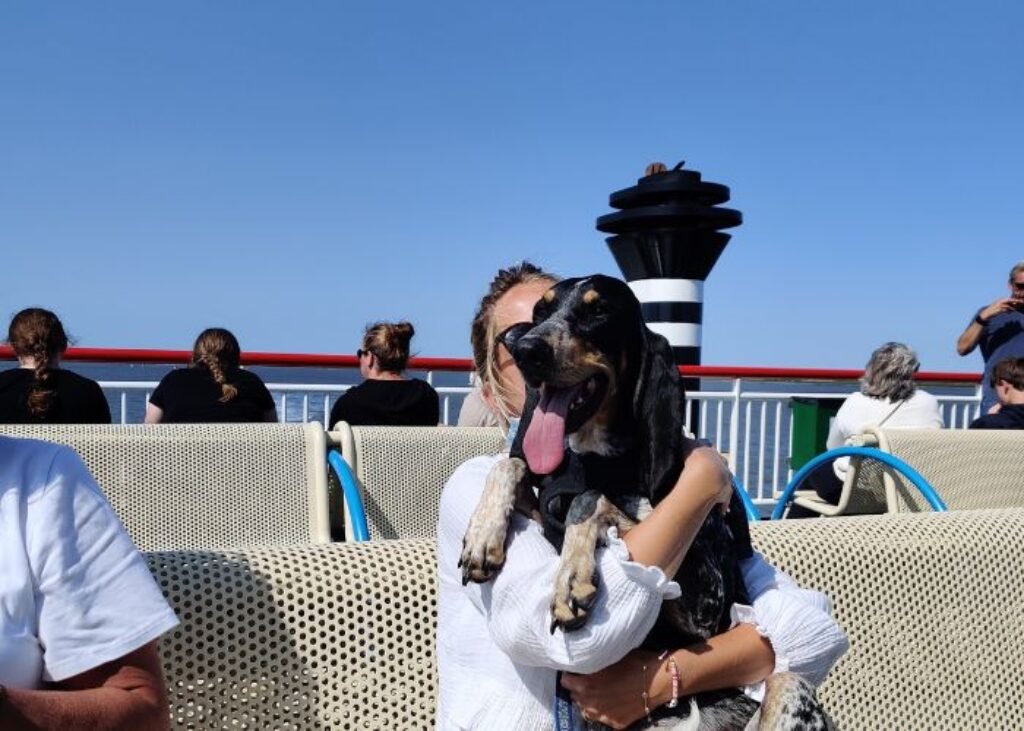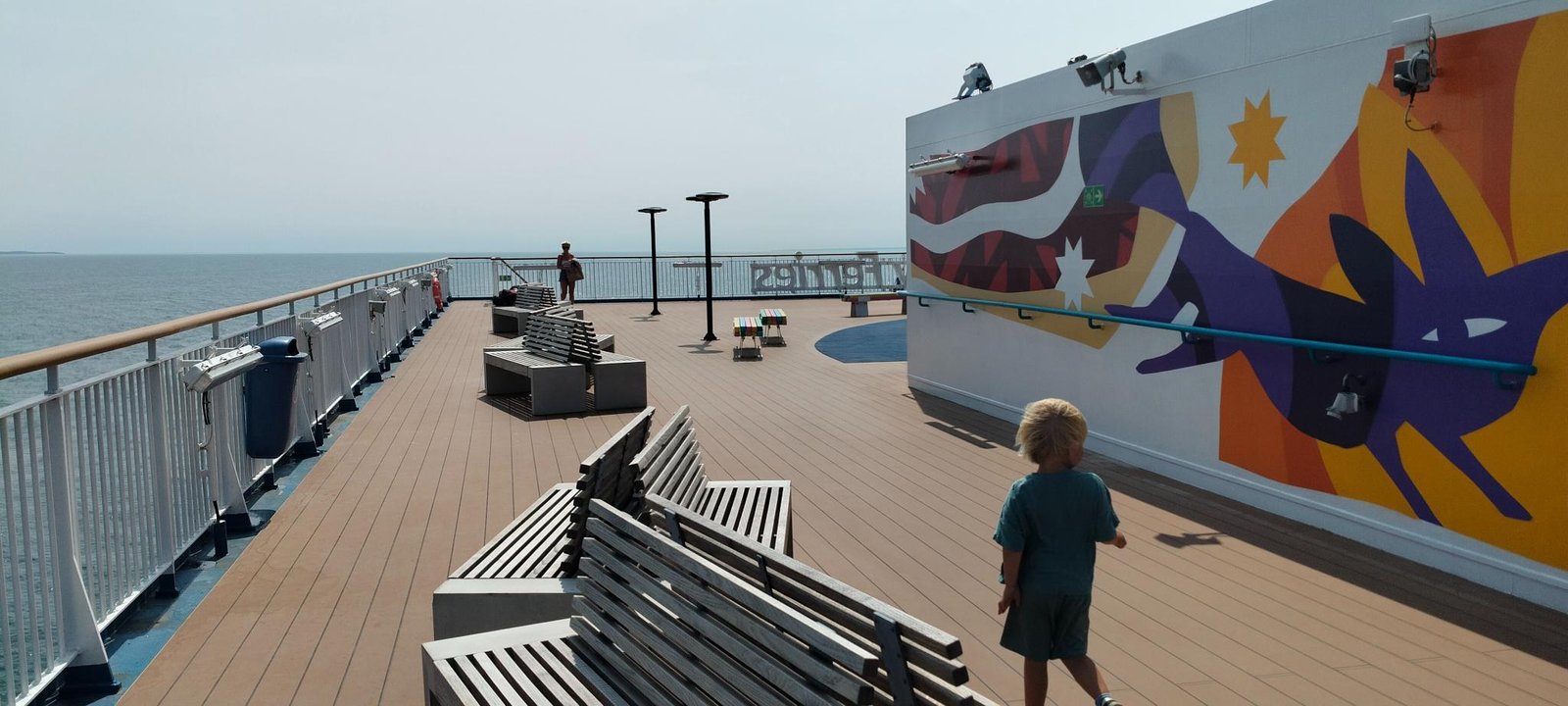Travelling with your dog on the ferry: Rules in Europe

Taking your dog on a ferry is possible across many European routes, but the rules vary by country and ferry company. It’s important to be aware of the specific requirements, such as pet passports, vaccinations, and whether your dog can remain in the car, stay in a kennel, or join you in designated pet areas. Always check the ferry company's policy before booking to ensure a smooth journey for both you and your pet. In this guide we'll highlight the rules of some of Europe's biggest ferry companies.
The policies of ferry companies regarding travelling with pets, including dogs, vary for each company. While the official regulations in the UK, for instance, are quite strict [1]Official rules: Travelling with a cat or dog, the rules on ferries tend to be somewhat more lenient. However, these rules differ between ferry companies.
In this article, we discuss everything you need to know about taking dogs and other pets on ferries.
- Are you allowed to bring your dog on the ferry?
- What conditions do you have to meet?
- Which ferry companies allow or do not allow dogs?
- How can you envision the journey for your dog on board (kennel, dog deck)?
- What about the dog passport?
- The rules can also differ by country.
- Costs of bringing your dog on the ferry by company
- Specific UK to Europe ferry rules for dogs.
Are dogs and pets allowed on the ferry?
The first question to be answered is whether you can bring your dog on the ferry. In many cases, the answer is yes, but this is often subject to various conditions. Many ferry companies offer a limited number of pet-friendly cabins and may also have specially designated areas for dogs on the ferry.
At many ferry companies, you can find information about whether you can bring your dog. For instance, DFDS offers pet-friendly cabins that can only be reserved by telephone (Pet Friendly Cabins, DFDS.com).
In many cases, dogs do not have access to public areas on ferries, but there is often a specifically designated area or deck where dogs can be walked.
When travelling with your dog, be aware that most companies limit the number of dogs to a maximum of two per cabin.
Contact your vet well in advance—at least four months—to discuss the conditions your dog must meet for travel, as these can vary by destination. You should also check your local government’s website for any import requirements needed.
The breed of your dog can also be important. In many countries, for example, pit bulls are not allowed. In France, among others, breeds/crosses of Staffordshire terriers, mastiffs, Boerboels, Tosas, and Rottweilers are also not welcome, and in Norway, the same rules apply to dog breeds as to France. Not all dogs are allowed in the UK either.
The banned dogs for the UK can be found on this list: Banned dogs in the UK.
Conditions for travelling with your dog or pet by ferry:
Dogs or other pets must:
- Have a valid (European or UK) pet passport when travelling internationally.
- Be microchipped: Your dog or pet must be microchipped and the microchip details recorded in travel documents, such as the pet passport (Travelling with Pets, DFDS.com).
- Have been vaccinated: All dogs must have been vaccinated against rabies, with proof. Vaccination requirements may vary by country, and it's important to note that the vaccination may need time to take effect before travel is permitted.
- An animal health certificate, or a valid pet passport that’s accepted in the country you’re travelling to
- Commonly (though not always) required for dogs: A tapeworm treatment before travelling to another country, which must often be recorded in the pet passport.
- Consider the breed of your dog: The breed of your dog can be significant to the destination country. For instance, certain breeds like pit bulls may not be welcome in many countries. More information on this can be found on national government websites.
- Have liability insurance: In many European countries, having liability insurance is mandatory.
However, in general terms, the answer to the question “Is the dog allowed on board?” Yes, this is possible, but under conditions.

Which ferry companies allow you to bring your dog on board?
Your dog may be taken on board certain ferry crossings provided it meets basic requirements such as having a dog passport, being chipped, and being vaccinated. Some of the ferry companies allowing dogs on board include:
- Brittany Ferries – Truly pet-friendly, although they have additional requirements such as extra toys and ‘nappy sacks' for dogs, which other ferry companies may not have. You can find more information here.
- Irish Ferries – Kennel facilities are available on each ship! These kennels can be booked in advance and are free of charge. Learn more about pet travel with Irish Ferries
- DFDS – Dogs are welcome aboard DFDS ferries, while interestingly, birds are not. More information about travelling with dogs with DFDS can be found here.
- Stena Line – Information about travelling with dogs can be found on this page. Stena Line sails to destinations including Hook of Holland – Harwich, Frederikshavn – Gothenburg, and Kiel – Gothenburg. Be sure to be aware of the rules regarding vaccinations and passports with Stena Line, these can differ per crossing.
- P&O Ferries Dogs – Pet rules for P&O Ferries can be found here. The cost to bring a pet varies per route, with the average price around €20.
- MobyLines – Animals are welcome at MobyLines. More information can be found here. MobyLines allows up to 3 pets in your cabin, compared to the regular policy of 2 pets per cabin for other ferries.
- Finnlines Dog Policy – Dogs are welcome too at Finnlines. Finnlines offers designated walking and walking decks, including a tree stump for dogs.
- Color Line – With Color Line, dogs must remain in the car or cage during the entire crossing. More information can be found here: Color Line pet policy.
- Fjord line – Dogs are welcome on Fjordline. For €13, you can have a dog kennel and small dogs are allowed in the car for €7. More information can be found at the Pet Information page of Fjord Line.
- Armas – Armas has specific requirements for bringing dogs on board. More information can be found here. At Armas it's a bit stricter than some other companies.
- Tallink Silja lines – Tallink Silja lines offer special pet cabins and/or kennels on board, with varying prices per route. More information can be found here: Tallink Silja Lines Pet Policy.
Specific rules apply to service/assistance dogs; in almost all cases, service dogs are welcome everywhere. Additionally, you do not have to pay to bring your assistance dog. The requirements of a passport and vaccinations of course do apply also to assistance dogs.
How does it work? Are there kennels, pet-friendly cabins, or a designated dog deck?
For shorter crossings, dogs are typically expected to stay with you during the journey. For instance, at Calais and Dover, there are special areas in both ports for pets to stretch their paws. On these shorter crossings, dogs are generally allowed to remain in the car or accompany their owner in specially designated pet lounges.
For short crossings without cabins, ensure your dog has eaten well in advance and has relieved itself shortly before departure, especially to mitigate seasickness.
During longer crossings, such as overnight journeys, animal-friendly cabins are often available. Additionally, there is usually a designated dog deck where your dog can be walked. In many instances, dogs are only permitted in these designated areas and animal-friendly cabins.
To reserve animal-friendly cabins, it's best to contact the shipping company directly by telephone, as some companies may only allow bookings via phone.
Dog passport for travel (or health certificate)
Planning a holiday or trip and bringing your dog along? Then you'll need an animal passport, whether you're travelling within or outside the UK or EU. If you don't have a dog passport yet, you can request one from an official veterinarian.
For travel within Europe with your dog, you'll also need a chip for identification, in addition to the European pet passport. Most dogs are microchipped and registered within 7 weeks of birth, but it's essential to double-check before your departure. Your vet can chip your dog if needed.
Vaccinations and Treatments for Travel
Next are the mandatory vaccinations and treatments: if you travel with your dog, it must be vaccinated against rabies. The vaccination must be completed no later than 21 days before departure. Dogs must also be treated against the fox tapeworm in many cases.
Is the dog younger than 12 weeks? Then they are too young to be vaccinated against rabies and are therefore not allowed to travel yet.
Dog Rules per Country
The rules for bringing your dog may vary slightly from country to country. Broadly speaking, there are four things to consider:
- A valid pet passport or an animal health certificate that’s accepted in the country you’re travelling to
- Microchipping
- Vaccination
- Tapeworm treatment
In some countries, there are restrictions on specific breeds and crosses. These exceptions can be clearly found per country in this extensive list of import requirements in Europe.
Price of Bringing Dogs on a Ferry
Finally, let's discuss the costs associated with bringing your dog on board. In some cases, you'll pay an additional fee for booking a pet-friendly cabin, and often you'll also need to purchase a ticket for the dog, unless it's an assistance dog.
In the table below, you'll find an overview of the costs per dog for a one-way ticket.
| Ferry company | Crossing | Costs |
|---|---|---|
| Color Line | All Transfers | €12 / £10 (in car) €18 / £15 (in kennel) |
| Corsica Ferries | All Transfers | €17 / £14 |
| DFDS | Dover - Calais | €18 / £15 |
| DFDS | Dover - Dunkirk | €18 / £15 |
| DFDS | Amsterdam - Newcastle | €32 / £27 |
| Fjordline | Hirtshals - Norway Routes | €7 / £6 (in car) - €13 / £11 (in kennel) |
| Mobylines | All Transfers | €15 / £13 |
| P&O Ferries | Calais - Dover | €15 / £13 |
| P&O Ferries | Rotterdam - Hull | €26 / £22 |
| Stena Line | Hook of Holland - Harwich | €18 / £15 |
| Tallink Silja | Helsinki - Talinn | €13 / £11) - €26 / £22) (night time transfer) |
| Tallink Silja | Stockholm - Tallin & Stockholm - Riga | €16 / £13 |
| Brittany Ferries | To France | €18 / £15 |
| Irish Ferries | All Routes | € 30 / € 45 / €60 (Kennel) (£25 / £50) |
Things to know before you travel with your pet!
- Animal-friendly cabins often have vinyl flooring or carpet to make it comfortable for your dog.
- If you're looking to travel by ferry and need a dog-friendly motorhome for the journey, you can rent one here.
- Some ferries even provide tree stumps for dogs to use.
- In reality, most ferries are a bit more relaxed about dog travel than their strict website rules suggest. However, this may not always be the case.
UK to Ireland and Europe: specific rules for travelling with a dog on a ferry from and to the UK.
Yes, your dog is welcome on board the ferry! All ferries to and from the UK to France and the Netherlands allow pets. There are even special pet-friendly cabins for night crossings. However, you do have to arrange several things in advance: for example, the aforementioned Rabies vaccination and a dog passport or a health certificate.
When travelling to an EU country or Northern Ireland, your pet must have, for the trip back almost the same rules apply.
- A microchip
- A valid rabies vaccination
- An animal health certificate or a valid pet passport accepted in the destination country
- Tapeworm treatment for dogs, specifically if you’re travelling directly to Finland, Ireland, Northern Ireland, Norway, or Malta
These requirements also apply to assistance dogs. Before you travel, be sure to check the regulations of the country you're visiting for any additional restrictions or requirements.
Dog on the ferry to France
Many of our visitors are specifically interested in taking their dogs on the ferry to France. Since France is part of the EU, the same rules apply as previously mentioned: you can take your dog on the ferry to France once you have met the necessar requirements. While rules may vary by company, in general, dogs are only allowed in designated pet areas on board the ship. There are some forbidden breeds in France however. Staffordshire terriers aren't welcome in France for example.
Rules for dogs per ferry company
Are you already set on which ferry to choose? Stena Line, DFDS, and P&O Ferries all sail to England. The regulations for bringing a dog vary depending on the ferry company.
Stena Line Dog Regulations: Harwich – Hook of Holland
Many travellers departing from the UK opt for the Harwich to Hook of Holland ferry route serviced by Stena Line vessels.
No need to fret; Stena Line welcomes dogs aboard their ships! If you're travelling by car or camper, you can bring a maximum of 5 dogs.
Your pet can remain in the vehicle during the journey, and you'll be given a coloured label for your car to indicate pet transportation. Please note that access to the car deck is restricted during the crossing, and you can only check on your dog with staff approval. Tip: reserving a kennel makes visits easier.
Passengers travelling on foot can bring a maximum of 3 dogs and must reserve a kennel or pet-friendly cabin. There's a small designated area on board where you can walk your dog. Unfortunately, your furry companion is not allowed in the restaurant, bar, or shop.
Cost: Bringing a dog on board Stena Line costs £15. An additional £3 is charged for kennel use. There are no extra charges for dogs in pet-friendly cabins.
DFDS: Dover/Calais – Calais/Dunkirk & Newhaven – Dieppe
DFDS operates between Dover – Calais and Dunkirk. These are short sailing routes, and dogs must remain in the car during the crossing. The car deck is closed during sailing. Would you like to check on your dog? Please discuss this with the onboard staff at the Guest Service Centre. Travelling from southern England? Consider the Newhaven to Dieppe ferry, with a journey time of 4 hours. The same dog regulations apply to this route.
Cost: Bringing your dog across the Channel to England costs £12.
DFDS: Newcastle – Amsterdam
Planning to take the ferry to Amsterdam (Netherlands) from Newcastle with your dog? You can choose the ‘Pet Hotel', a spacious kennel equipped with food and water bowls and a tap. You can visit your dog here anytime and walk them in a designated deck area.
Alternatively, you may prefer to book a pet-friendly cabin to spend the entire journey together. These cabins accommodate up to 4 people and a maximum of 2 dogs. Cost: A dog ticket to Newcastle costs £28.
P&O Ferries: Dover – Calais
P&O Ferries warmly welcomes dogs on board. On the short crossing between Calais and Dover, dogs typically remain in the car unless the Pet Lounge is reserved. In the lounge, you can relax with your dog, place your own dog basket, grab refreshments, and enjoy fresh air on the dog deck.
Cost: bringing your pet on board to Dover costs £10. An additional £10 per person grants access to the Pet Lounge.
P&O Ferries Dog Regulations: Hull – Rotterdam
P&O Ferries offers dog-friendly cabins on the Hul to Rotterdam route. Travelling with your furry friend on this long journey is made comfortable with specially designated pet cabins located near the dog walking area. Dogs are not permitted in other areas of the ship.
Cost: a dog-friendly cabin costs approximately £25 extra.
Tips and Experiences?
Do you have any tips for travelling with your dog by ferry? We're very curious! We'd also love to hear about our visitors' experiences of travelling by ferry with their dog. Please feel free to share your experiences in the comments!
References[+]References[−]
| ↑1 | Official rules: Travelling with a cat or dog |
|---|---|
| ↑2 | Taking your pet abroad, Gov. UK |
JW, one of the co-founders of FerryGoGo, has a passion for food, drink and travel. He loves exploring data and the history of the destinations featured on FerryGoGo, and he’s always curious about the population of each place. He’s also sailed many of the ferry routes between the UK and the continent himself; from Saint-Malo–Portsmouth to overnight crossings such as Portsmouth–Cherbourg and Newcastle–Amsterdam - so his guides are grounded in first-hand experience.







I do not see Condor Ferries mentioned in the information.
This article provides a comprehensive guide on travelling with dogs on ferries. It emphasizes that the rules vary among ferry companies, making it essential to check the specific regulations for each company. While some ferry companies have strict rules regarding pets, many do allow dogs on board, albeit subject to certain conditions. Some ferries have pet-friendly cabins, while others have designated areas or decks for dogs. It is important to contact the vet well in advance to understand the requirements and vaccinations needed for the trip, as they may differ depending on the destination. Breed restrictions also exist in certain countries, such as the UK, France, and Norway. Overall, this article serves as a valuable resource for dog owners planning to travel by ferry.
Thanks ‘Dog Kennels in Auckland’ =)
Would be awesome if you would link from your site towards this article that you describe as ‘the most comprehensive guide on travelling with dogs on ferries.” ! Much appreciated and we are happy that the guide was able to help you.